
This post may contain affiliate links or sponsored content. That means if you click on my link and buy something, I will earn a small commission from the advertiser at no additional cost to you. For more information on this, please click here.
Enjoying Sicilian Cheesecake with Ricotta, Orange and Almond is a favorite Easter tradition in my home. It’s a great recipe to share with family and friends on holidays and special occasions, is easy to make, and can be made well in advance and frozen.

I love a classic, cream cheese-based New York-style cheesecake from time to time. But nothing beats its Italian counterpart–the ricotta cheese-based cheesecake.
Lighter in texture, less rich and less sweet than its richer and denser American counterpart, this Sicily-inspired version still has all the decadence and creaminess to satisfy any dessert craving.
For another delicious, ricotta-based dish that’s typical of Easter check out my super-easy version of classic Italian Easter Meat and Cheese Pie, aka. Pizza Rustica!
Italian with American Influences
This cheesecake recipe is a bit of a culinary mash-up. The light, airy ricotta filling with lots of orange and a touch of almond is classic Sicilian (and exactly how my Sicilian-American mom made it), while the crust is signature American–but with a major touch of Sicilian-ness infused into it.
Many New York-Style cheesecakes contain a simple, crispy graham cracker crust. It’s so beloved that lots of people think this is the best part!
Here, I’ve replaced half the graham crackers with almonds and added a significant amount of orange zest to my graham cracker crust in a very Mediterranean island, non-American way. You will just love it!
The ricotta cheese filling is silky smooth, not overly sweet and has the most delightful tangy taste. Bursting with bright citrus flavor and a touch of almond, this Sicilian cheesecake totally captures the essence of the Mediterranean.

Why You’ll Love This Recipe
Between the creamy and super-flavorful ricotta cheese filling, the crispy almond-orange graham cracker crust and the light and airy texture, not to mention the aroma that will be floating through your kitchen, there are so many reasons to love this Sicilian cheesecake.
One more is that it freezes beautifully and can be made well in advance of serving, easing the overload of tasks often accompanying any big event.
This Sicilian cheesecake definitely deserves a spot on your next holiday or special occasion menu. It’s a great year-round favorite!

Ingredients for Sicilian Cheesecake
Here are the ingredients we’ll need for this ricotta cheesecake recipe:
- Ricotta Cheese: The star of the show and the base for this dreamy, Sicilian cheesecake recipe. Use whole milk ricotta at room temperature and be sure to strain it for an hour or two to remove excess liquid.
- Orange Zest: Orange zest provides the defining, beautiful, aromatic flavor to this cheesecake. And, as some of the world’s best oranges grow at the foot of the Mt Etna volcano in Sicily, it’s a perfect ingredient for this luscious dessert. Note that most conventional oranges are laced with a wax coating, so I try to seek out either organic oranges or those that are specifically labeled as “unwaxed” for this recipe.
- Almonds: The almonds (and orange zest) add a unique slant to the graham cracker crust, infusing some Sicilian-ness into the very American type of crust. Either blanched or unblanched almonds can be used but they should be raw (not roasted). In place of starting with whole almonds for the crust, you can use purchased almond meal. Almond flour is a bit too fine for this recipe.
- Graham Crackers: Used as the base for the crust, graham crackers are a type of semi-sweet whole wheat cookie flavored with hints of honey and cinnamon. They’re widely available in the US and can be substituted with vanilla wafers or shortbread cookies if you’re unable to find them. I used Nabisco brand original graham crackers in this recipe. Pre-ground graham cracker crumbs can also be used.
- Butter: Use unsalted butter and melt it for the crust. Melted butter binds the tiny crumbs together and makes this crust taste unbelievably buttery and delicious. Butter also helps prevent the cake sticking to the springform pan. Do not use margarine.
- Eggs: Eggs are the binder in the recipe. Use large eggs at room temperature.
- Sugar: As the graham cracker crust bakes, the sugar crystals assist the butter in binding the crumbs together. Since graham crackers are already sweet, we don’t need to use much sugar in the crust. Most of the sugar gets combine with the ricotta for the filling. Having said this, this cheesecake is not overly sweet.
- Extract: Enhances the flavor of the cheesecake. All orange, all vanilla, or a combination of them can be used. I like to include a touch of almond extract as well to complement the almonds in the crust and overall flavors of the cake, increase the cake’s Sicilian-ness plus add a little bit of je ne sais quoi.
- Flour: A small amount of all-purpose flour is used to thicken the filling a bit.

How to Make Sicilian Cheesecake, Step-by-Step!
The 3 parts of making this cheesecake include making the crust, making the filling and baking the cheesecake.
- Gather all ingredients. Strain the ricotta cheese. Zest the oranges. Butter the bottom and sides of a 9” springform pan.
- PRO-TIP: Be careful not to include any pith (i.e., the white part between the orange peel and the fruit) as it is very bitter when zesting the orange. A microplane zester is the best tool to do this. Click here for a demonstration on how to do it.


- Then, grind the graham crackers and almonds together in a food processor or blender. Combine them with the sugar.
- PRO-TIP: It is normal (and really great) to have slightly bigger bits of the almonds in the crust mixture. You will LOVE the final texture it creates!
- Melt the butter over low heat and stir in the orange zest. Pour the butter mixture into the crumb mixture and mix until well-combined and until the mixture holds together when squeezed in your hand. The texture should be similar to wet sand–thick and coarse.



- Then, firmly press this mixture evenly into the bottom and along the sides of the springform pan with your hands, applying medium-firm pressure until the crumbs are set.
- PRO-TIP: Use a flat-bottomed measuring cup to help smooth out and gently pack down the crust into the pan and up the sides. It should be compact, but not so tight that it bakes into a hard crust.
- Transfer the unbaked crust to a middle rack in a 350°F preheated oven and bake for 10 minutes. Remove and let the crust cool at least 10 minutes before filling it.


- Next, make the filling. Place the sugar in a bowl and sift the flour into it. Stir together. Beat the eggs with the extracts and zest.
- PRO-TIP: Since zest is a bit moist and tends to clump together, it’s best to stir it into the butter (for the crust) and the eggs (for the filling) to ensure that it gets evening distributed throughout the crust and cake.
- Using a rubber spatula or a large spoon, gently fold the sugar mixture into the ricotta until well-combined. Then, add the egg mixture to the ricotta a little at a time, gently mixing until well-blended and smooth.
- PRO-TIP: Do not use an electric mixer as it may cause overmixing and break the cheese.



- Carefully pour the batter in the cooled graham cracker crust. Poke a few “holes” into the batter with the spatula to prevent air pockets, then smooth the top with the spatula.
- Bake the cheesecake on the middle rack in a 350°F preheated oven for 55-72 minutes or until the cake is firm all the way to the top center.
- PRO-TIP: Begin checking it at 55 minutes. The exact amount of time will depend on your oven.



- Allow cheesecake to cool completely at room temperature, then cover with plastic wrap and refrigerate. When ready to serve, remove cake from the springform pan and carefully transfer it to a plate. The cake should be refrigerated for at least 3 hours to set before serving.
- PRO-TIP: For a clean slice, use a sharp, smooth (not serrated) knife and run it under hot water then wipe it dry before every slice.

Frequently Asked Questions
It will hold for up to 5 days covered in the refrigerator and up to 3 months wrapped tightly in plastic wrap in the freezer. Thaw in the refrigerator before serving.
You can also make and bake the graham cracker crust up to 2 days in advance, if desired, and hold it uncovered at room temperature.
No! A water bath is not necessary for this recipe. Just place the pan directly on a rack in the middle of the oven.
Although I have never had a problem with the cheesecake leaking out of the springform, I always place an empty sheet pan on a rack directly underneath the cheesecake as a precaution.
What’s the difference between Sicilian cheesecake and regular cheesecake?
The main difference between a typical New York-style cheesecake and Sicilian or Italian cheesecake is the cheese that is used. In Italy, cheesecake is made with ricotta cheese, whereas American cheesecake is made with cream cheese.
Italian/Sicilian cheesecake is lighter in texture, less rich and less sweet than its richer and denser American counterpart.
No. While I recommend par-baking this crust, it is not absolutely necessary. Par-baking the crust creates a crispy, sturdy crust with an almost cookie-like texture, so I definitely recommend it!
You can liken it to the difference between a cannoli that is prefilled (not par-baking the crust) versus one that is filled to order (crispier, par-baked crust).
If you are short on time, you can skip the par-baking step.

Yes, but you will then likely need two purchased graham cracker crusts for this amount of filling, though I have not tested this.
A homemade graham cracker crust is much easier and quicker than you may realize. Plus, you will be able to add the almonds and orange zest to the crust if you make if from scratch as opposed to using a purchased crust.
There’s a few things that you can do to avoid cracks in your cheesecake. One is to let the cheesecake cool slowly by turning off the oven and cracking the door open BEFORE the cake is done and leaving the cake in there for about 15 minutes. (Note: I have not tried this as it was never needed with this recipe.)
Another is to not overmix the ingredients. I indicate in the recipe that an electric mixer should not be used and that only a spatula held in your hand is needed. This should help prevent overmixing as does starting with room temperature ingredients that are easier to mix. When the batter is overmixed, too much air is added and may cause the cake to rise in the oven and then collapse and crack when being removed.
Don’t overbake the cake–it may crack if it’s too dry.
Grease the pan–as the cake cools, it contracts. And, if any part of the cake is stuck to the side of the pan as it cools and shrinks, it may pull and split.
If you do end up with some cracks, no worries! The cake will still be delicious and the cracks add character. Just be creative with a bit of whipped cream or berries as a topping to cover it up if it bothers you.

Variations and Substitutions
Here are a few notes on variations and substitutions for this Italian cheesecake:
- Change the Nut: I love using almonds in the crust as it is a typical Sicilian ingredient. Having said this, you can experiment with different nuts. Although I have not tested it, pistachio, hazelnut or walnuts all sound like great options. If you prefer to leave out the nut and make a more basic graham cracker crust, that’s okay, too!
- Add some chocolate chips to the batter.
- Swap out the extract to vary the flavors: Regarding extracts, I have made this cheesecake with all orange and all vanilla extract and have loved them both, so the choice is yours. I include a little almond extract as it complements the almonds in the crust and overall flavors of the cake, but you can leave it out if desired.
- Add some lemon: You can substitute up to half of the orange zest with lemon zest, if desired.
- Go Crust-Free: Be more traditional and eliminate the crust entirely. The cheesecake will still be awesome. Still butter the pan and I suggest sprinkling it lightly with a dusting of graham craker crumbs or flour. Note that the cake will not be as tall without the crust.

TOP TIPS FOR SICILIAN CHEESECAKE
- Ricotta: Use a good quality, whole milk ricotta and be sure to strain it for about 1 hour to remove excess liquid. If you have an Italian specialty store near you that makes their own ricotta in-house, by all means use that!
- Room Temperature eggs and ricotta cheese work best. Be sure to let them sit out for 1 to 2 hours prior to using.
- Mixing: Use a rubber spatula to mix the batter. Do not use an electric mixer as it may cause overmixing and break the cheese.
- No water bath necessary! Just bake the cheesecake directly on a middle rack in the oven.
- Par–Bake the graham cracker crust for the best, crispy crust.
- Allow the cheesecake to set up in the refrigerator for at least 3 hours before slicing into it and serving.
- Use a springform pan (since you can’t invert this cheesecake to get it out of a regular pan) and don’t forget to butter the bottom and sides.
- Serving: This is a versatile dessert that can be served lots of ways–plain, dusted with powdered sugar, sprinkled with toasted sliced almonds, topped with a dollop of whipped cream or a drizzle of honey, or with fresh berries.
- Store the ricotta cheesecake in the refrigerator, covered, for up to 5 days or freeze it for up to 3 months wrapped tightly in plastic wrap and foil. Thaw in the refrigerator before serving.
More Great Recipes to Try
I hope that you are enjoying Mangia With Michele and all of my Italian recipes!
If you’ve tried this Sicilian Cheesecake or another recipe here, please let me know in the comments below. I love hearing from you!
FOLLOW ME on FACEBOOK and INSTAGRAM to see more delicious food and what might be going on behind the scenes!

Sicilian Cheesecake with Ricotta, Orange and Almond
Equipment
Ingredients
For The Crust:
- 8 ounces graham crackers (15 whole Nabisco brand crackers, or about 2 level cups graham cracker crumbs)
- 8 ounces raw almonds, blanched or unblanched (about 1⅓ level cups whole almonds; See NOTES.)
- 3 Tbsp sugar
- 4 ounces unsalted butter (1 stick) + more to grease pan
- Grated zest from 2 oranges (See NOTES.)
For The Filling:
- 2 pounds whole milk ricotta cheese at room temperature, drained (See NOTES.)
- ¾ cup sugar
- ⅓ cup all-purpose flour
- 6 large eggs, at room temperature, beaten
- 2 tsp orange or vanilla extract
- 1 tsp almond extract
- Grated zest from 2 oranges (See NOTES.)
Optional/Garnish:
- Powdered sugar
- Sliced almonds, lightly toasted
Instructions
- Place a rack in the center of the oven and preheat oven to 350℉. Prep and gather all ingredients. Butter the bottom and sides of a 9” springform pan.(Please see the section above in the blog post for Step-By-Step instructions with photos.)
- Put the ricotta in a strainer or fine mesh sieve propped over a bowl and let it drain out excess liquid for 1 to 2 hours at room temperature. (You can line it with cheesecloth if you have it.) Discard the liquid and transfer the strained ricotta to a large bowl and set aside.2 pounds whole milk ricotta cheese
Make The Crust:
- Place the graham crackers and almonds in a food processor or blender and pulse until they are the consistency of breadcrumbs. (It is normal (and really great) to have slightly bigger bits of the almonds in the crust mixture. (See close-up photo above.) You will LOVE the final texture it creates!)8 ounces graham crackers, 8 ounces raw almonds,
- Transfer this crumb mixture to a bowl and combine them with the sugar. (NOTE: If you don’t have a food processor or blender just put the crackers and nuts in a zip-lock bag and crush them with a rolling pin. Since the crumbs need to be fine, you will have to put some elbow grease into it!)3 Tbsp sugar
- Melt the butter over low heat and stir in the orange zest.4 ounces unsalted butter, Grated zest from 2 oranges
- Pour the butter mixture into the crumb mixture and mix until well-combined and until the mixture holds together when squeezed in your hand. If needed, add a little more melted butter. The texture should be similar to wet sand–thick and coarse. Smash/break up any large chunks.
- Then, firmly press this mixture evenly into the bottom and along the sides of the springform pan with your hands, applying medium-firm pressure until the crumbs are set. (You don’t want any loose crumbs.) The crust does not need to come all the way up the sides of the pan, just an inch or so.
- Use a flat-bottomed measuring cup to help smooth out and gently pack down the crust into the pan and up the sides. It should be compact, but not so tight that it bakes into a hard crust. You can also run a spoon along the bottom corners to keep a rounded shape.
- Transfer the unbaked crust to a middle rack in a 350℉ preheated oven and bake for 10 minutes. Remove and let the crust cool at least 10 minutes before filling it. Note that the crust will be soft after it’s removed from the oven, but will set and harden in a short amount of time.
Make The Filling:
- Place the sugar in a bowl and sift the flour into it. Stir together.¾ cup sugar, ⅓ cup all-purpose flour
- Beat the eggs with the extracts and zest.6 large eggs,, 2 tsp orange or vanilla extract, 1 tsp almond extract, Grated zest from 2 oranges
- Using a rubber spatula or a large spoon, gently fold the sugar mixture into the ricotta until well-combined. (NOTE: Do not use an electric mixer as it may cause overmixing and break the cheese.)
- Then, add the egg mixture to the ricotta a little at a time, while continuing to mix gently with spatula or spoon until well-blended and smooth.
- Carefully pour the batter in the cooled graham cracker crust. Poke a few “holes” into the batter with the spatula to prevent air pockets, then smooth the top with the spatula. (NOTE: Expect the batter to be very loose.)
Bake the Cheesecake:
- Transfer pan to a middle rack in a 350℉ preheated oven and bake for 55-72 minutes or until the cake is firm all the way to the top center. Begin checking it at 55 minutes. The exact amount of time will depend on your oven. (In my electric oven, it almost always takes exactly 72 minutes.) The top will be brown around the edges. (See photo above.)
- Allow cheesecake to cool at room temperature, then cover with plastic wrap and refrigerate.
Serving:
- This cheesecake is best chilled at least a few hours. It should have at least 3 hours in the refrigerator to set before serving. When ready to serve, remove cake from the springform pan and carefully transfer it to a plate.
- Dust the top of the cake with some powdered sugar and sprinkle the slices with toasted sliced almonds, if desired. For a clean slice, use a sharp, smooth (not serrated) knife and run it under hot water then wipe it dry before every slice. Buon Appetito!Powdered sugar, Sliced almonds,
Notes
- Regarding extracts, I have made this cheesecake with all orange and all vanilla extract and have loved them both, so the choice is yours. I include a little almond extract as it complements the almonds in the crust and overall flavors of the cake, but you can leave it out if desired.
- You can strain the ricotta a night ahead and allow the ricotta to drain overnight in the refrigerator. But, be sure to bring the ricotta to room temperature for 1 to 2 hours before using.
- Be careful not to include any pith (i.e., the white part between the orange peel and the fruit) as it is very bitter when zesting the orange. A microplane zester is the best tool to do this.
- Also, as conventional oranges generally contain a wax coating, I try to seek out either organic oranges or those that are specifically labeled as “unwaxed” for this recipe.
- Since zest is a bit moist and tends to clump together, it’s best to stir it into the butter (for the crust) and the eggs (for the filling) to ensure that it gets evening distributed throughout the crust and cake.
- In place of starting with whole almonds for the crust, you can use purchased almond meal. Almond flour is a bit too fine for this recipe.
- You can make and bake the graham cracker crust up to 2 days in advance, if desired, and hold it uncovered at room temperature.
- Also, I always par-bake this crust, but it is not absolutely necessary. I love that it creates a crispy, sturdy crust with an almost cookie-like texture, so I definitely recommend it! But, if you are short on time, you can skip this step.
- Although I have never had a problem with the cheesecake leaking out of the springform, I always place an empty sheet pan on a rack directly underneath the cheesecake as a precaution.
- Store the ricotta cheesecake in the refrigerator, covered, for up to 5 days. It also freezes really well for up to 3 months! To freeze it, wrap the chilled cheesecake tightly in plastic wrap then a layer of foil and/or place it in a freezer bag. You can also wrap and freeze individual slices. Thaw in the refrigerator before serving.

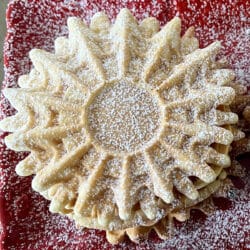

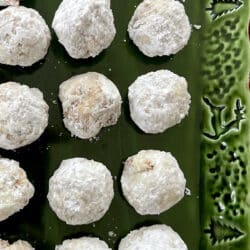
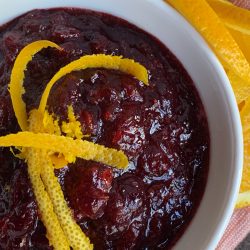
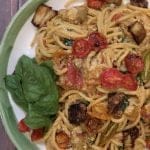
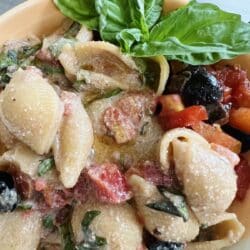

My family loved this cheesecake and commented on how light and flavorful it is with the creamy ricotta cheese, crunchy crust and hint of orange. I will make this again!
My springform pan was 10”, which is larger than the recipe called for, so I made 1.5x the recipe. I used all of the crust and almost all of the filling so it wouldn’t overflow. It took just a few minutes longer to bake and I checked it frequently. It turned out perfectly and now we have a new family favorite!
Delicious! Raves from around the table! Those who had chosen other desserts had to have a ‘sliver’, which was easy to cut! Everyone was amazed at how light it was – perfect after a heavy meal preceded by an array of starters.
Full disclosure, I left out the orange zest from the crust cuz I was prepping toooo much food! Maybe why it was a little hard getting the crust to stick, but it worked & I figured it out later. (I threw the zest into the ham glaze) Next, there was a crater in the center of filling that didn’t go away till 70 minutes, so the filling was brown all the way across.
BUT, before serving my daughter shook powdered sugar over the top and it was a huge success!! I will definitely make this again!
Thank you for another great recipe!
This looks amazing.
I’m looking forward to making this for Passover this year!
My family and I LOVED this recipe, especially the crust. Can’t wait to make it again!